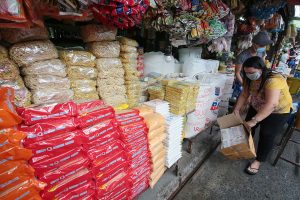WHOLESALE PRICE growth slowed to 6.8% in February, the Philippine Statistics Authority (PSA) reported on Monday, with the central bank’s monetary tightening starting to take effect to contain inflation, analysts said.
Preliminary data from the PSA indicated that the general wholesale price index (GWPI) rose by the lowest rate in two months or since the 6.7% posted in December.
The February reading was below the 7% reported in January but higher than the year-earlier 5.6%.
In the year to date, the GWPI averaged 6.9%, well up on the 5.1% posted a year earlier.
In an e-mail, ING Bank N.V. Manila Senior Economist Nicholas Antonio T. Mapa said rate hikes by the Bangko Sentral ng Pilipinas (BSP) to counter inflation probably “sapped” demand, which led to slower price growth in February.
Prices of mineral fuels, lubricants and related materials contributed to the GWPI slowdown, rising 5.6% in February from the 14.2% reported in January.
“Moderating global energy prices may be surfacing onshore, leading to the dip to 5.6%,” he added.
Among the eight commodities in the index, six posted slower growth. Price growth in crude materials, inedible except fuels slowed to -31.2% in February from -27.2% in January, as did that of chemicals including animal and vegetable oils and fats (-1.2% from 0.1%).
Manufactured goods classified chiefly by materials posted 6.1% price growth in February from 3.9% in January.
In a Viber message, Asian Institute of Management Economist John Paolo R. Rivera said that the slowdown in the GWPI reflects the delayed impact of monetary tightening by the BSP.
“We are now seeing the expected effects of policy adjustments. It may have taken time due to sticky prices and slow adjustments of economic agents or market players,” he said.
Among the major island groups, wholesale price growth in Luzon and Mindanao slowed to 7% in February from 7.2% in January, and to 5.1% from 5.5%, respectively.
Price growth in the Visayas came in at 5.3% in February from 4.9% a month earlier. This was the highest reading since the 5.6% posted in December.
In Luzon, six commodities also posted slower price growth led by mineral fuels, lubricants and related materials, which came in at 5.4% from 14.8% the previous month.
Price growth slowed for one commodity in the Visayas (mineral fuels, lubricants and related materials at 5.1% in February from 8.6% in January), while two commodities posted slower growth in Mindanao (Food at 8.8% from 10.3%, and chemicals including animal and vegetable oils and fats at 0.4% from 0.5%).
Inflation fell to 7.6% in March from 8.6% in February. This was the lowest reading since the 6.9% posted in September.
Core inflation remained high at 8%, the highest level since the 8.2% posted in December 2000.
Analysts said the market has still not resolved the issues that are keeping prices high.
“The problems in supply chain and production (are) still persistent. These have to be addressed because monetary tightening can only do so much and may harm the economy in the long run,” Mr. Rivera said.
“We can see a downward trajectory for prices although we believe inflation should remain sticky and return to BSP’s target only by the end of the year,” ING Bank’s Mr. Mapa said. — Bernadette Therese M. Gadon

